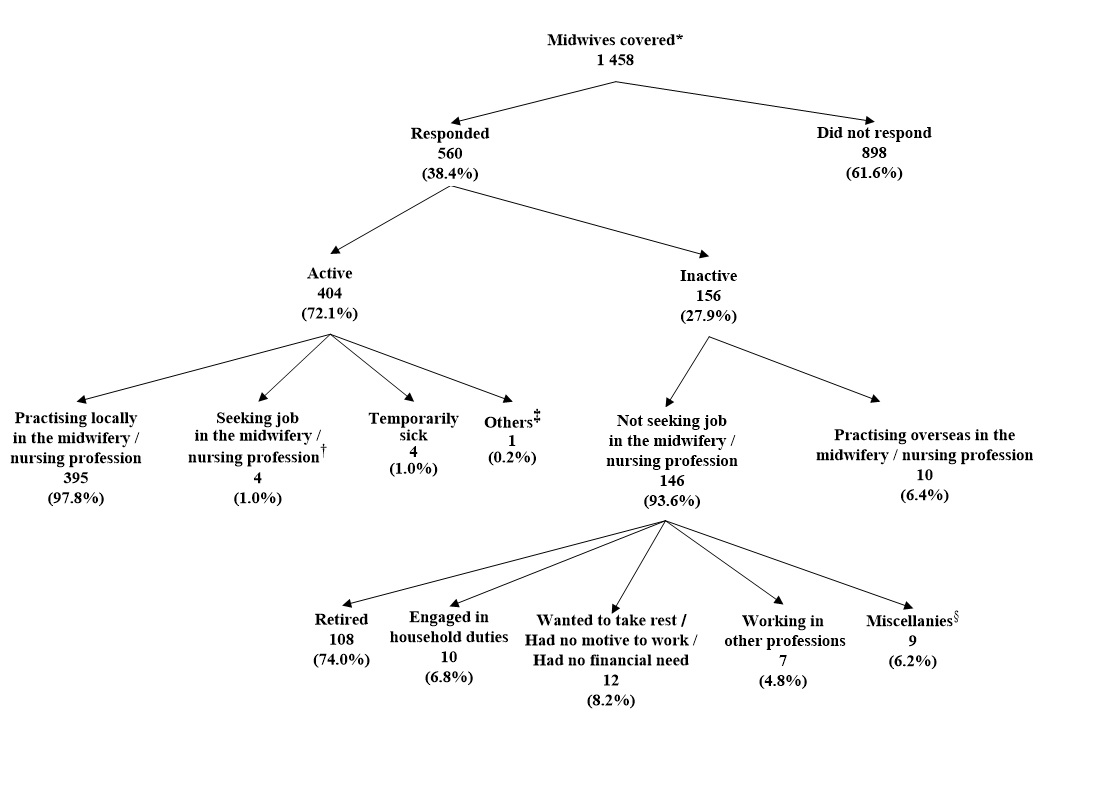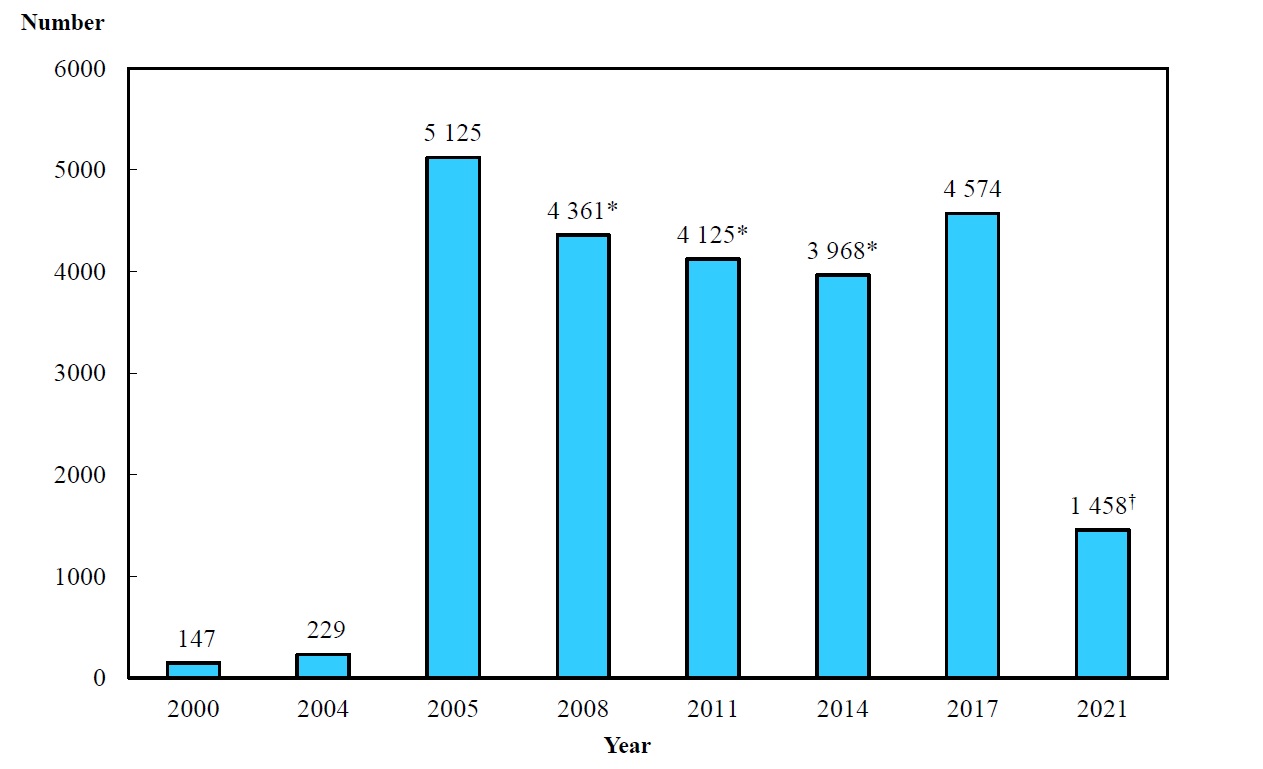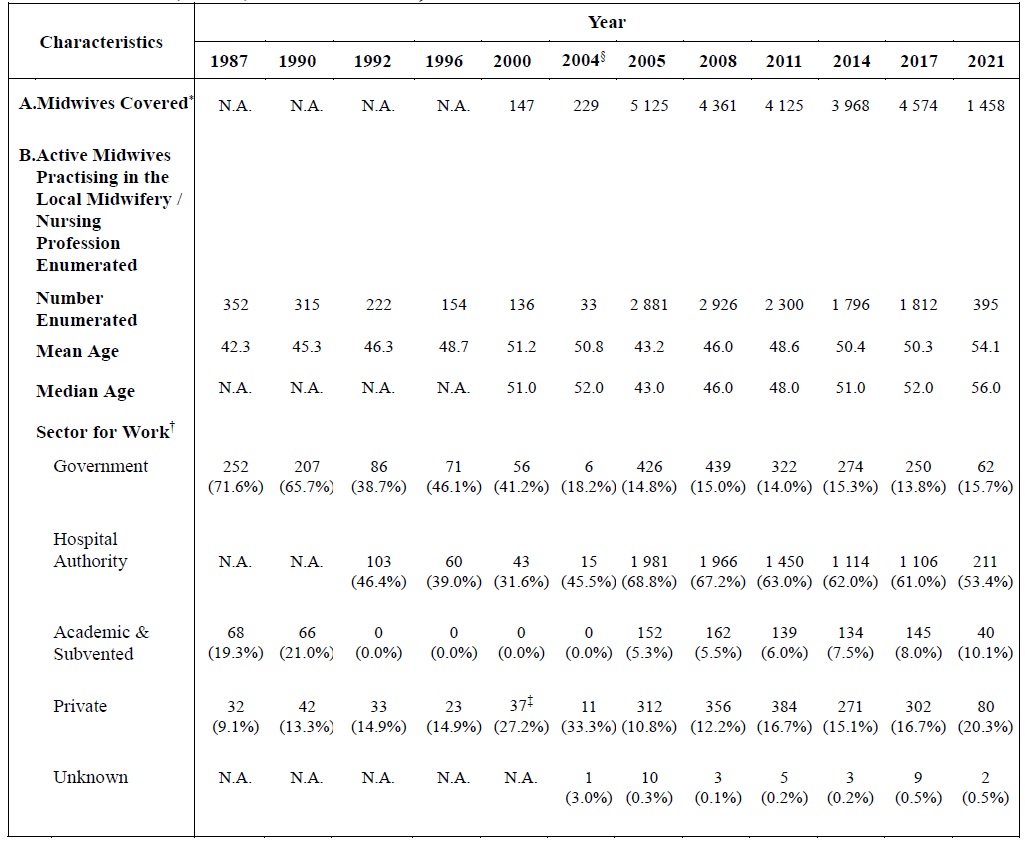Statistics
2021 Health Manpower Survey
Summary of the Characteristics of Registered Midwives Enumerated
I. Midwives Covered
1.1 The midwives covered in the 2021 Health Manpower Survey on Midwives (HMS-MW) were midwives registered with the Midwives Council of Hong Kong under the Midwives Registration Ordinance (Chapter 162) as at the survey reference date of 31 July 2021, and had provided written consent on receiving information related to HMS-MW by post or email.
1.2 Among the 4 400 midwives registered with the Midwives Council of Hong Kong as at the survey reference date of 31 July 2021, 1 458 had consented to receive information related to HMS-MW by post or email. The number of midwives covered was 1 458.
II. Response Rate
2.1 Of the 1 458 midwives covered, 560 responded to the HMS-MW, giving an overall response rate of 38.4% (Chart A).
III. Activity Status
3.1 The responding midwives were classified as either “economically active”* or “economically inactive”*. Economically active (“active”) midwives included:
(a) “employed” midwives - midwives practising in the midwifery / nursing profession in Hong Kong during the survey period; and
(b) “unemployed” midwives - midwives who (i) were not practising in the local midwifery / nursing profession during the survey period; (ii) had been available for work during the seven days before the survey† AND (iii) had sought work in the local midwifery / nursing profession during the 30 days before the survey‡.
3.2 Economically inactive (“inactive”) midwives referred to the responding midwives who were not practising in the midwifery / nursing profession in Hong Kong during the survey period, excluding those who were on leave during the survey period and who were “economically active” but “unemployed”.
3.3 Among the 560 responding midwives, 404 (72.1%) were “active” and 156 (27.9%) were “inactive” in the local midwifery / nursing profession as at 31 July 2021 (Chart A).
| * | In the survey, the criteria used in defining economically active / inactive followed those recommended by the International Labour Organization, which are also being used by the Census and Statistics Department in Hong Kong. |
| † | The respondent would be classified as “unemployed” if he / she had sought work in the local midwifery / nursing profession but had not been available for work because of temporary sickness. |
| ‡ | The respondent would also be classified as “unemployed” if he / she fulfilled conditions (i) and (ii) but had not sought work during the 30 days before enumeration because he / she believed that work was not available; or had made arrangements to take up a new job; or was starting business on a subsequent date; or was expecting to return to the original job in the local midwifery / nursing profession. |
3.4 Among the 404 active midwives, 395 (97.8%) were practising in the local midwifery / nursing profession, four (1.0%) were seeking jobs in the midwifery / nursing profession, four (1.0%) reported that they had not been available for work because of temporary sickness and one (0.2%) reported that she was available for work but had not sought work during the 30 days before enumeration as she was expecting to return to her original job in the local midwifery / nursing profession. The survey results presented in paragraph 3.5 to 3.16 below were based on the 395 responding midwives who were practising in the local midwifery / nursing profession as at 31 July 2021. The percentages presented below may not add up to 100% due to missing responses or rounding (Chart A).
3.5 Of the 156 (27.9%) inactive midwives enumerated, 146 (93.6%) reported not seeking jobs in the midwifery / nursing profession during the 30 days before enumeration and ten (6.4%) reported practising overseas. Among the 146 inactive midwives who reported not seeking jobs in the midwifery / nursing profession, the main reasons included: 108 (74.0%) were retired, 12 (8.2%) wanted to take rest / had no motive to work / had no financial need, ten (6.8%) were engaged in household duties, nine (6.2%) were emigrated and seven (4.8%) were working in other professions (Chart A).
3.6 All the 395 active midwives practising in the local midwifery / nursing profession enumerated were female. Excluding one respondent who did not indicate her age, the median age of the remaining 394 active midwives was 56.0 years. Among them, those aged 55 to 59 years accounted for the largest proportion (38.0%), followed by those aged 60 to 64 years (18.0%) and those aged 50 to 54 years (17.2%).
3.7 The responding active midwives practising in the local midwifery / nursing profession were requested to indicate the characteristics of their main jobs*. Among the 395 respondents, 211 (53.4%) of them reported as working in the Hospital Authority, 80 (20.3%) in the private sector, 62 (15.7%) in the Government, 23 (5.8%) in the subvented sector and 17 (4.3%) in the academic sector.
3.8 For the active midwives practising in the local midwifery / nursing profession enumerated, the median age for those working in the academic and subvented sectors was 60.0 years, whereas the median ages for those working in the Government, the private sector and the Hospital Authority were 57.0 years, 56.0 years and 56.0 years respectively.
3.9 Of the 395 active midwives practising in the local midwifery / nursing profession enumerated, 30.4% spent most of their working time on obstetrics, while 12.2% reported spending most of their working time on public health, 9.6% reported administration / management and 9.4% reported ambulatory care / outpatients as the main area of work.
3.10 The median number of hours of work per week (excluding meal breaks) of the 395 active midwives practising in the local midwifery / nursing profession enumerated was 40.0 hours, amongst which 38 (9.6%) were required to undertake on-call duty (excluding normal duty), with a median of 12.5 hours of on-call duty (excluding normal duty) per week.
3.11 Among the 395 respondents, 65.6% had received Student / Pupil Nurse Training, 14.4% held Bachelor’s Degree, 6.8% received Pupil Midwife Training and 6.6% held Higher Diploma as their earliest basic qualification†.
| * | Main jobs referred to the jobs in which the midwives had spent most of their working time. |
| † | Earliest basic qualification refers to the minimum entry qualification to the midwifery / nursing profession obtained by the midwives. If the midwives had the minimum entry qualifications in both nursing and midwifery professions, they were requested to choose the earlier qualification that they had obtained between these two qualifications as the earliest basic qualification. |
Chart A : Activity Status of Midwives Covered

| Note: | * | Figure refers to the number of midwives who had registered with the Midwives Council of Hong Kong under the Midwives Registration Ordinance (Chapter 162) on or before 31.7.2021 and who had provided written consent to receive information related to HMS-MW by post or email. |
| † | Figure refers to the number of responding midwives who (a) were not practising in the midwifery / nursing profession in Hong Kong during the survey period; (b) had been available for work during the seven days before the survey; AND (c) had sought work in the local midwifery / nursing profession during the 30 days before the survey. | |
| ‡ | Figure refers to the number of responding midwives who (a) were not practising in the midwifery / nursing profession in Hong Kong during the survey period; (b) had been available for work during the seven days before the survey; AND (c) had not sought work during the 30 days before enumeration because he/ she believed that work was not available; or had made arrangements to take up a new job; or was starting business on a subsequent date; or was expecting to return to the original job in the local midwifery / nursing profession. | |
| § | Figure refers to the number of responding midwives who reported emigrated. | |
| Percentages may not add up to 100% due to rounding. |
3.12 Of the 395 active midwives practising in the local midwifery / nursing profession enumerated, 389 (98.5%) had received / were receiving additional training after obtaining their earliest basic qualification, amongst which 113 (29.0%) held Master’s Degree, 103 (26.5%) held Bachelor’s Degree, 103 (26.5%) held Diploma as the highest qualification and two (0.5%) had not yet completed the additional training.
3.13 Of the 389 respondents who had received / were receiving additional training after obtaining their earliest basic qualification, 153 (39.3%) had received / were receiving training in one field only, which included training in midwifery (94.1%), emergency / first aid nursing (2.0%), nursing administration (1.3%) and public health nursing (1.3%).
3.14 Of the 389 active midwives practising in the local midwifery / nursing profession who had received / were receiving additional training after obtaining their earliest basic qualification, 236 (60.7%) indicated more than one field of additional training. The most commonly reported fields included: midwifery which was reported by 234 (99.2%) of the 236 respondents, nursing administration which was reported by 50 (21.2%) of the respondents, general nursing which was reported by 45 (19.1%) of the respondents and public health nursing which was reported by 43 (18.2%) of the respondents.
3.15 Among the 395 active midwives practising in the local midwifery / nursing profession, 240 (60.8%) reported that they had participated in Post-registration Education in Midwifery (PEM) activities in 2021, 150 (38.0%) reported no participation in any PEM activities and five (1.3%) did not report whether they had participated in any PEM activities or not. Among the 240 respondents who had participated in PEM activities, the distribution of PEM points / hours attained in the past 12 months was: 1 to 5 points / hours (27.9%), 6 to 10 points / hours (20.4%), 11 to 15 points / hours (17.1%), 16 to 20 points / hours (8.8%) and more than 20 points / hours (25.8%).
3.16 Among the 395 active midwives practising in the local midwifery / nursing profession, 327 (82.8%) reported that they had participated in Continuing Nursing Education (CNE) activities in 2021, 65 (16.5%) reported no participation in any CNE activities and three (0.8%) did not report whether they had participated in any CNE activities or not. Among the 327 respondents who had participated in CNE activities, the distribution of CNE points / hours attained in the past 12 months was: 1 to 5 points / hours (11.0%), 6 to 10 points / hours (14.4%), 11 to 15 points / hours (23.5%), 16 to 20 points / hours (14.7%) and more than 20 points / hours (36.4%).
IV. Trend Analysis
4.1 As there have been changes to the survey method, reference date and coverage for 2021 HMS-MW, findings of the survey cannot be directly comparable to previous surveys.
4.2 The midwives covered in 2021 HMS-MW were those registered with the Midwives Council of Hong Kong as at 31 July 2021, and had provided written consent on receiving information related to HMS-MW by post or email. The scope covered in 2021 is different from the previous surveys and constituted approximately 33% of the midwives registered with the Midwives Council of Hong Kong under the Midwives Registration Ordinance (Chapter 162) as at the survey reference date.
4.3 In terms of coverage, number of midwives covered for HMS prior to 2004 referred to the active midwives practising in the institutions enumerated. With the introduction of practising certificate by the Midwives Council in January 2000, the method adopted in counting midwives had been changed to include midwives who had valid practising certificates in midwifery as at the survey reference date. Survey coverage between 2004 and 2017 is summarised as follows:
- in 2004 only midwives who had valid practising certificates in midwifery as at the survey reference date and had no valid practising certificate in registered nurses or enrolled nurses were covered.
- in 2005 all midwives registered with the Midwives Council of Hong Kong as at 31 August 2005 were covered.
- in 2008, 2011 and 2014 midwives registered with the Midwives Council of Hong Kong as at 31 August of the respective years and who had to renew their practising certificates in the respective survey years were covered.
- in 2017 midwives registered with the Midwives Council of Hong Kong as at 31 August 2017 were covered, excluding those who were later found to have passed away on or before the survey reference date.
4.4 Given the changing survey methodologies, the number of midwives covered ranged between 147 and 5 125 during the survey years between 2000 and 2021.
4.5 Selected characteristics of active midwives practising in the local midwifery / nursing profession enumerated during the survey years between 1987 and 2021 were tabulated in Table A for reference.
Chart B : Number of Midwives Covered by Year (2000, 2004, 2005, 2008, 2011, 2014, 2017 and 2021)

| Note: | * | As the 2008, 2011 and 2014 Health Manpower Survey only aimed at covering all midwives who had to renew their practising certificates in 2008, 2011 and 2014, midwives who did not need to renew practising certificates in 2008, 2011 and 2014 were excluded from the survey. |
| † | The midwives covered in 2021 were midwives who had registered with the Midwives Council of Hong Kong on or before 31.7.2021 and who had provided written consent to receive information related to HMS-MW by post or email. | |
| Figure of 2000 refers to the number of midwives without registered nurses and enrolled nurses qualification and reported by the responding institutions as at 1.7.2000, whereas in 2004 only midwives who had valid practising certificates in midwifery as at 31.8.2004 and who had no valid practising certificate in registered nurses or enrolled nurses. Survey coverage in 2005 covered all midwives registered with the Midwives Council of Hong Kong as at 31.8.2005. In 2008, 2011 and 2014 midwives registered with the Midwives Council of Hong Kong as at 31 August of the respective years and who had to renew their practising certificates in respective years were covered. In 2017 refers to the number of midwives registered with the Midwives Council of Hong Kong as at 31 August 2017 were covered, excluding those who were subsequently found to have passed away on or before the survey reference date. |
Table A : Selected Characteristics of Active Midwives Practising in the Local Midwifery / Nursing Profession Enumerated (1987, 1990, 1992, 1996, 2000, 2004, 2005, 2008, 2011, 2014, 2017 and 2021)

| Note: | * | Figure of 2000 refers to the number of midwives without registered nurse qualification and enrolled nurse qualification and reported by the responding institutions as at 1.7.2000, whereas in 2004 only midwives who had valid practising certificates in midwifery as at 31.8.2004 and who had no valid practising certificate in registered nurses or enrolled nurses were covered. Survey coverage in 2005 covered all midwives registered with the Midwives Council of Hong Kong as at 31.8.2005. In 2008, 2011 and 2014 midwives registered with the Midwives Council of Hong Kong as at the 31st of August of the respective years and who had to renew their practising certificates in respective years were covered. In 2017 midwives registered with the Midwives Council of Hong Kong as at 31 August 2017 were covered, excluding those who were found to have passed away on or before the survey reference date. The midwives covered in 2021 were midwives who had registered with the Midwives Council of Hong Kong on or before 31.7.2021 and who had provided written consent to receive information related to HMS-MW by post or email. |
| † | In 2004, 2005, 2008, 2011, 2014, 2017 and 2021, the sector refers to the sector for the main job. | |
| ‡ | Included academic sector. | |
| § | As the number of active midwives practising in the local midwifery / nursing profession involved was very small, interpretation of the corresponding statistics should be cautious. There may be slight discrepancy between the sum of individual items and the total due to rounding. |
|
| N.A. | Not applicable |